
Meriv çawa Pythonek Kesk ji Doghead Boa vedibêje
Many people often confuse these two species, considering them to be extremely similar, however, if you look closely, you will notice that these are completely different snakes. We will not touch on the anatomical differences between boas and pythons, but we will indicate only some of the most pronounced EXTERNAL signs:
1) The shape and size of the head.
The boa has a much more massive head than the python, the muzzle is more elongated, the back is wide and voluminous, in contrast to the compact head of the chondra.
2) Thermolocators.
The head of the boa constrictor is replete with thermolocators, they are both under the lower lip and above the entire upper lip. In chondra, well-distinguishable thermal pits are only under the lower lip.
3) Shielding of the head.
Pay attention to the size of the scutes / scales on the front of the head – in the boa constrictor they are large and differ in size from the rest of the scales. The chondra has small scales that do not differ from the rest.
4) Drawing.
In most (not all!!!) dog-headed boas, the pattern along the back is made up of transverse white serifs, darkened at the edges. I don’t presume to say that this is an ironclad argument, but I have never seen a green python with such a pattern. I hope this manual will help you understand the difference between these two species)
Thermolocators above the upper lip, large shields on the “nose” – Dog-headed boa
Small scales on the “nose”, thermopits only on the lower lip – Green python
Clearly defined white transverse markings – Corallus caninus
The almost complete absence of a pattern (but in this case this is not an indicator) – Morelia viridis
An elongated massive head, a wide back of the head – a dog!
Small head, non-stretched nose, narrow nape – chondru
Author — Andrey Minakov





